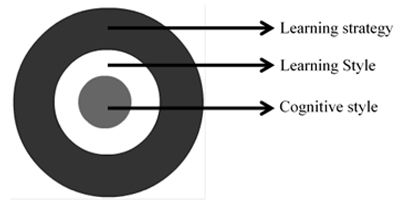
doi.org/10.15198/seeci.2020.52.119-147
RESEARCH
DESIGN, PRODUCTION AND IMPLEMENTATION OF LEARNING ENVIRONMENT BASED ON WEB, LEBW
DISEÑO, PRODUCCIÓN E IMPLEMENTACIÓN DEL AMBIENTE DE APRENDIZAJE BASADO EN WEB, AABW
DESIGN, PRODUÇÃO E IMPLEMENTAÇÃO DO AMBIENTE DE APRENDIZADO BASEADO NA WEB, AABW
Rómulo Andrés Gallego Torres1
1Colegio Mayor de Cundimarca. Colombia
[1] Rómulo Andrés Gallego Torres: Master in Information Technology Applied to Education. Professor Colegio Mayor de Cundimarca. Bogota Colombia.
andresgallegot@gmail.com
ABSTRACT
The work presented here is part of the need to contribute to science education through ICT. In this sense, a WEB-based environment was designed, which presents in its structure a didactic strategy of scaffolding of a metacognitive type, which was designed in the context of learning certain contents of textual typology in relation to the Sciences Natural. The research raised a quasi-experimental design of type 2x3, with previously formed groups belonging to two regular courses of a private school in the city of Bogotá. The experience consisted of exposing groups of students to a WEB-based environment for strengthening reading comprehension and scientific skills. The results of this research contribute to teachers, therapists and in general to the Educational Community elements regarding the use of a metacognitive scaffolding in a WEB-based environment, as a teaching strategy for the development of metacognitive processes and learning achievement. Such an integrated strategy along with the cognitive style in the students' DFI dimension could predict the academic success of apprentices when interacting with such environments.
KEYWORDS: WEB-based environments, metacognitive scaffolding, metacognitive judgments, DFI dimension, Metacognition, LMS, reading competence
RESUMEN
El trabajo que aquí se presenta, forma parte de la necesidad de contribuir a la educación en ciencias a través de las TIC. En este sentido, se diseñó un Ambiente Basado en la WEB, el cual presenta en su estructura una estrategia didáctica de andamiaje de tipo metacognitivo, el cual, se diseñó en el contexto de aprendizaje de ciertos contenidos de tipología textual en relación con las Ciencias Naturales. La investigación planteó un diseño cuasiexperimental de tipo factorial 2x3, con grupos previamente conformados pertenecientes a dos cursos regulares de un colegio privado de la ciudad de Bogotá. La experiencia consistió en exponer a los grupos de
estudiantes a un Ambiente Basado en la WEB para el fortalecimiento de la comprensión lectora y las competencias científicas. Los resultados de esta investigación aportan a docentes, terapeutas y en general a la Comunidad educativa elementos frente al uso de un andamiaje metacognitivo en un Ambiente Basado en la WEB, como estrategia didáctica para el desarrollo de los procesos metacognitivos y el logro de aprendizaje. Dicha estrategia integrada junto con el estilo cognitivo en la dimensión DFI de los estudiantes podría predecir el éxito académico de los aprendices cuando interactúan con este tipo de ambientes.
PALABRAS CLAVE: ambientes basados en la WEB, andamios metacognitivos, juicios metacognitivos, dimensión DFI, Metacognición, LMS, competencia lectora
RESUMO
O trabalho aqui apresentado, faz parte da necessidade de contribuir à educação em ciências através das TIC. Neste trabalho, foi criado um Ambiente Baseado na WEB, este apresenta na sua estrutura uma estratégia didática de andaimes do tipo metacognitivo, o que foi criado no contexto de aprendizado de alguns conteúdos de tipología textual relacionados com as Ciências Naturais. A pesquisa propõe um design quase experimental de tipo fatorial 2x3, com grupos previamente escolhidos pertencentes a dois cursos regulares de uma escola privada da cidade de Bogotá. A experiência consistiu em expor aos grupos de alunos ao Ambiente Baseado na WEB para o fortalecimento da compreensão da leitura e as competências científicas. Os resultados desta pesquisa trazem a professores, terapeutas e a toda Comunidade educativa em geral, elementos diante do uso de andaimes de tipo metacognitivo em Ambientes Baseados na WEB, como estratégia didática para o desenvolvimento dos processos metacognitivos e conquista do conhecimento. Dita estratégia integrada com o estilo cognitivo na dimensão DFI dos alunos poderia prever o sucesso acadêmico dos aprendizes quando interactuam com este tipo de ambientes.
PALAVRAS CHAVE: ambientes baseados na WEB, andaimes metacognitivos, julgamentos metacognitivos, dimensão-DFI, Metacognição, LMS ,competência leitora
Correspondence:
Rómulo Andrés Gallego Torres. Colegio Mayor de Cundimarca. Colombia.
andresgallegot@gmail.com
Received: 11/09/2019
Accepted: 04/12/2019
Published: 15/07/2020
How to cite the article:
Gallego Torres, R. A. (2020). Design, production and implementation of learning environment based on web, LEBW. [Diseño, producción e implementación del ambiente de aprendizaje basado en web, AABW]. Revista de Comunicación de la SEECI, (52), 119-147. doi: http://doi.org/10.15198/seeci.2020.52.119-147
Recovered from http://www.seeci.net/revista/index.php/seeci/article/view/617
1. INTRODUCTION
The changing dynamics of today's world proposes different challenges, requiring people capable of developing thought processes that allow them to approach, understand and solve different problems. In a society where information management is privileged, it is of great importance to promote the development of reading competence, emphasizing the interpretative and constructive character that this exercise requires; since reading implies in addition to recognizing and interpreting different sign systems, reflecting on our own thinking, becoming aware of the processes involved in carrying out a task, in order to strengthen critical thinking, flexible and reflective creative (Cerchiaro, Paba, & Sánchez, 2011), (Cantillo, De la Hoz, & Cerchiaro, 2014).
In this sense, it is important to understand that there are two interdependent reading processes: a) the processes of recognition of the signs and characters and b) the macro process of reading comprehension; for Snowling & Hulme affirms:
(...) reading competence goes beyond the domain of word recognition skills or reading fluency, and a strategic domain of the high-level cognitive processes involved in reading comprehension is also necessary for the Achieving a deep interpretation and understanding of the text (in Gundín, Fidalgo, & Robledo, 2012).
In this way, there is a close link between reading comprehension and metacognitive activity. Understanding this, as the ability of an individual to possess control over his thoughts and to maintain awareness of the same, in order to integrate their knowledge to the concrete demands of a changing world, where the management of the information and the capacity of quick and effective answers are privileged (De Corte, 1999).
In accordance with the foregoing for the national scope, it was included from the second semester of 2014 in the know 11th applied to last grade students from all over the country, the critical reading component, which aims to favor a transformation oriented to strengthen the evaluation of interpretative and logical reasoning capacities from a text and to avoid declarative knowledge. This component involves the development of different competencies on the part of the student, in order that this one manages to approach critically to a text must, in the first place, understand the local units of sense. Secondly, it must integrate that information to give a global sense to the text. And, thirdly, once the previous two stages have been overcome, it must take a critical stance against the text, reflecting on its content (ICFES, 2013).
However, taking as a reference to Herrera (2005) develop skills to think critically and creatively, be flexible in the forms and methods of observing a reality and give answers that are effective in their application; skills embedded in metacognition are a great educational challenge, in that sense, Tamayo (2016) they say: the Metacognition “is still considered fundamental not only in the processes of teaching and of learning but, in addition, in the constitution of the critical thought”.
On the other hand, the competence of reading comprehension in international tests has shown great difficulties; taking into account the performance of students from the eight Latin American countries, these are still far from the quality standards defined by the Organization for Economic Cooperation and Development (OECD) which through the PISA test evaluates students' competencies in math, reading and natural science. For the specific case of reading the results thrown by the Colombian students evaluated in year 2012 report that:
51% of the students did not reach the basic level of competition, and 31% were placed at level 2, that three out of ten Colombian students can detect one or more this means fragments of information within a text; in addition, they recognize the main idea, understand relationships and build meanings within texts that require simple inferences, and can compare or contrast from a unique feature of the text. In levels 5 and 6 there are only 3 out of every thousand young people, who can make multiple inferences, make detailed and accurate crossings and contrasts; they demonstrate a broad and detailed understanding of one or more texts, and make a critical assessment of a text whose content is unfamiliar (ICFES, 2013, p. 9).
For 2015, Colombia improved SUS statistics in the field of reading comprehension, although we are still lagging with reference to the countries of the first world, this year the figures did not put in the couple of countries like Mexico, Turkey, among others, reaching 425 points, 22 more than in 2012. The most problematic result is that 43% of Colombian minors do not exceed the OECD's minimum standards in this area (OCDE, 2016).
Therefore, reflections are raised from the academic field, in a concrete way from the teaching activity with high school and university students by highlighting the difficulties that young people present in the development of the reading competition. Generating interest to know about the variables that affect the process of reading comprehension in digital format.
Metacognition, as a mental activity by means of which other processes or mental states become the object of reflection constitutes an important variable in the process of reading comprehension, according to Cerchiaro, Paba, & Sánchez (2011) and Cantillo, De la Hoz & Cerchiaro (2014) two key metacognitive components are distinguished to regulate reading comprehension; knowledge of the purpose of reading and self-regulation of mental activity to achieve that goal; it reports that the less competent readers show insufficient knowledge of the purpose of the task and of the reader strategies, as well as a deficient ability to oversee their own comprehension process.
In accordance Paba & González (2014) established the relationship between metacognitive activity and reading comprehension in high school students, finding that metacognitive activity in the sample is null and therefore the reading comprehension level is low.
From this perspective and in order to encourage the development of metacognitive strategies Molenaar y Sleegers (2010), Van de Pol, Volman, Oort, & Beishuizen (2015) propose the use of metacognitive scaffolds, which have the function of managing and regulating cognitive processes. This type of scaffolding allows the subject to raise learning goals consistent with the interests and time available, in the same way it helps him to oversee the advance against the proposed goal and to reflect on the results obtained, in search of reorienting strategies that have proved unsuccessful in achieving the desired learning achievements.
Another variable related to the performance in reading comprehension in digital format by the students is the cognitive style, concept proposed by Witkin in 1948; according to Hederich et al. (2013) and Hidalgo & Olaya (2016) the cognitive style in the dependency dimension-field independence (DFI) establishes differences between the subjects, related to the capacity of cognitive restructuring, information processing, competences Interpersonal and motivations between two subjects' polarities: the so-called Independent and Field-dependent. These differences affect the learning process, the achievement of individual learning and the way in which students access knowledge in computational environments (López-Vargas, & Hederich-Martínez, 2011), (López, Ibáñez, & Chiguasuque, 2014).
In this context Korthauer & Koubek (2009) establish the effect of the cognitive style of the subjects and their relation with the tasks developed in hypertextual environments, finding that the independent students of field present more exactness in their tasks of learning compared with Field-dependents, which makes it possible to deduce that these students have greater skills in analyzing and synthesizing information. With respect to the performance of field-dependent students, it was found that they did not correctly use explicit aids in a hypermedia environment and require more time to perform the task.
Taking as a reference the previous framework this research aims to design an Environment Based on the WEB that implements within its structure a metacognitive scaffolding, which through metacognitive activators aims to promote the development of the metacognitive capacity of the students and, consequently, possibly to improve the reading comprehension of the same ones when they interact with texts in digital format.
2. RESEARCH OBJECTIVE
2.1. General objective
Create and validate a metacognitive-type scaffolding in a web-based learning environment for the development of metacognitive processes in reading comprehension and learning achievement in natural sciences, minimizing differences between students with different cognitive styles.
2.2. Specific objectives
3. APPROACH TO THE PROBLEM
The purpose of this study is to analyze different aspects related to the metacognitive processes in reading comprehension in order to encourage the reflection and implementation of strategies that facilitate the attainment of learning goals and the Problem solving in students (Jiménez, 2004). From this perspective, an Environment Based on the WEB was designed, which presents in its structure a didactic strategy of scaffolding of metacognitive type; this scaffolding was designed in the context of learning certain textual type content in relation to the natural sciences. Consequently, in addition to the development of metacognitive capacity, interaction with this computational environment is expected to favor students in relation to the expected learning achievement.
The results of this research contribute to teachers, therapists and in general to the educational community elements against the use of metacognitive scaffolding in an Environment Based on the WEB, as a didactic strategy for the development of metacognitive processes and learning achievement. This integrated strategy along with the cognitive style in the DFI dimension of the students could the academic success of the apprentices when they interact with this type of environments.
In the same way, the results of this research regarding the design and development of web-based learning environments could be considered by training educators and educators in information technology and communication. As they constitute an important resource for the students of different cognitive style because it favors the development of their metacognitive capacity in reading comprehension and therefore the possibilities to achieve the expected academic achievements. In this sense, the central problem of this research can be summed up through the following question:
What is the effect of metacognitive scaffolding on the achievement of natural science learning in high school students who interact with web-based learning environments?
4. SOME THEORETICAL REFERENCES
4.1. Metacognition in web-based learning environments-AABW
The communications revolution in post-industrial societies has led to a shift in the forms of production, distribution and consumption: the emphasis of the productive circuit lies in the so-called immaterial work (creation and production of symbolic goods; to say, information, knowledge and know-how whose infrastructure is based on different forms of language expression). Not only do the ways of producing change: they also change the forms of perception and expression, which has a profound impact on the configuration of knowledge and, of course, it affects the traditional ways of understanding pedagogy. The presence of actors in the process learning education is no longer a requirement and the centrality of the textbook and the teacher are moving to give shape to new modalities of pedagogical communication.
In this sense, the virtual education or e-learning contributes to a better learning because in many areas it is considered that the education external to that of the classroom is more propitious considering the revolution of the knowledge, this has generated that the students develop autonomous learning, in addition to being considered as digital natives and are accessing information from the different devices at your fingertips, you should think of a metacognitive strategy in the field of ICT. First, they have transformed the cognitive process and as Unifi defines it, a new kind of intelligence has been generated, the distributed intelligence that is defined as “intelligence is not an ascribed property of the minds of individuals, but it is distributed among people, and between people and physical tools and symbolic systems” (Herrero & Brown, 2010), this has led to new paradigms and new ways of teaching and learning such as Connectivism, which tries to demonstrate that through learning networks, social media, self-learning and personal environments of learning, in addition to the use of ICT, students can produce their knowledge autonomously, making their construct transcended from the virtual classroom and be evaluated by both them and their peers, simply leaving the teacher as mediator of I learned it (Gallego Torres, 2017).
Secondly, it must be considered that thanks to the use of computational environments, according to Karl Stephen (Sierra, Carrascal, & Buelvas, 2014) can be divided into two types: Container system which is how the environments have been used of virtual learning commonly, are pre-established information repositories and focused on the environment and resources offered by the different platforms and content system where information and content are provided and shared by the users, achieving an appropriation of the course by the students who are involved in the process not only as receivers of knowledge but as prosumers that means that They consume and produce the necessary information to achieve the learning objective proposed by the course, this is achieved with the articulation of the content proposed by the students and with the activities, evaluations and feedbacks of both pairs and teachers using asynchronous tools such as forums, blogs, etc.
For this research was used a mixture of the styles because in the Moodle was used as a repository of contents, but the thematic evaluations were conducted suggesting to the students to make a feedback through the forums Published in each unit, this would make it possible for students to participate in their learning process and generate the ability to regulate learning, looking for what is called blended lives, the students interact mixing their reality between the face and the virtual, they are connected, immersed in the different existing platforms, Internet, Smart TV, etc., achieving to create real personal learning environments achieving an autonomous learning (Sierra, Carrascal, & Buelvas, 2014).
Last but not least, there are metacognitive mediation strategies in virtual environments, since this topic is central in the research project, but are the metacognitive strategies, according to Isabel Sierra in her doctoral thesis Strategies of metacognitive mediation in conventional and virtual environments: influence in the processes of self-regulation and autonomous learning in students defines them as:
[...] They are the set of actions oriented to know the own operations and mental processes [...] They are applied by the subject, during and after their learning processes and have the objective of optimizing their executions in a conscious way (Sierra, 2010).
In other words, they are the strategies that the students perform Mayer (Sierra, 2010), they can be divided into three categories; A) which allow the planning of cognitive actions, B) which allow to perceive the advance of the goal and C) those that modify the plan or adjust the action as required.
It can be defined that the Metacognitive judgments are the questions that arise from both the students and their teachers that allow to evaluate their learning processes, these can be abstract, do you have clear the characteristics of an expository text?, or is ready to demonstrate its understanding of this text, its standards are based on the social context or are created by it, this favors the generation of critical thinking in the students making their learning regulating and guiding to the path that will lead to self-learning.
There are several investigations in which their research base is the AABW, will take the examples in Colombia, to start this research is carried out in the pilot University of Colombia titled a didactic Strategy in the Web-based learning environments: scaffolding regulating, conducted by Nicolás García D. in 2014, the test was conducted to 50 university students and sought the development of self-regulating skills learning problem solving Mathematicians through the achievement of expected learning, in this research the results were positive because they showed that the scaffolding regulating implemented in the AABW impacted in a positive way in the achievement of learning, also evidenced that no there were significant differences in the results caused by the cognitive style and end up recommending the development of AABW conducive to learning regulating as they encourage reflection and control of their own learning process, helping positively on the motivation of the students when addressing these tasks (García, 2015).
Secondly, it analyzed the research carried out by Isabel Sierra P. quality of learning and processes of metacognition and self-regulation in virtual and dual environments in higher education, the research was based on establishing the relationship between the strategies of metacognitive teaching in virtual environments and the levels of development of the autonomous learning and as this motivated the strategies of self-regulation in the learning of university students in this case of sixth semester of the Faculty of Education of the University of Cordoba in Colombia, this study used the typology of virtual environments, which divides them into:
4.2. Individual Learning Differences
Within each academic group there is evidence of differences between the students who constitute it, some of these differences are due to factors associated with gender, religious beliefs, ethnicity or economic, social or cultural aspects; these differences are framed within the emotional, social or cognitive field, from this the concept of style is elaborated (Lozano, 2006).
The styles
they are considered as a set of characteristics that people have related to their behaviors in those areas where they act and relate. This is useful for analyzing the different forms of action. The styles conform the categorization of the various behaviors that make each person particular and original (Renes & Martínez, 2016).
The style is defined as the set of regularities characteristic of the subjects that determine their behavior and is characterized by being: 1) differentiating, to the extent that it establishes distinctive characteristics among the people; 2) relatively stable in each individual; 3) Integrator of the different dimensions of the subject, and 4) neutral, that is to say, that one should not be valued, in absolute terms, a style above another (Hederich-Martínez, 2007).
The second category is the styles of learning, referring to the preferences that students have when it comes to processing information or in front of the realization of a learning task (Alonso, C., Gallegos, D., y Honey, P. 1997), (Cerchiaro, Paba, & Sánchez, 2011).
In the educational field, on some occasions the two categories described above are used in terms of learning style and cognitive style; however, these concepts are different, in order to differentiate between these two concepts it is useful to use the model proposed by Curry, in 1987, who proposes “The Model of The Onion” (graph 1).
Source: López, Hederich y Camargo (2011).

Graph 1. Curry Onion Model.
4.3. The cognitive style in the dimension DFI
In Hederich (2013), the cognitive style that has possibly been most studied is the dependency-independence of field (DFI) style which was proposed by Witkin (1948), this dimension determines differences between subjects related to the capacity of cognitive restructuring, information processing, interpersonal competencies and motivations between two polarities of subjects: the so-called independent and field dependents.
These differences in subjects directly affect the learning process, individual academic achievement and how to access knowledge in computational environments (Hederich-Martínez & Camargo-Uribe, 2018), the subjects categorized as independent of field have greater skills of cognitive restructuring, which is evident in their ability to unmask simple figures in complex figures, to process information in an analytical way, situation that it favors the time to deepen the concepts previously acquired and establish relationships between these. In the same way, they have strategies that facilitate the storage and retrieval of the information, they show preferences towards the individual work and they have intrinsic motivation (López-Vargas & Hederich-Martínez, 2011), (García, 2015), (Hederich-Martínez, 2007).
At the other pole are located subjects called field dependent also called sensitive to the environment, which have lower capacities in relation to Cognitive restructuring, process information in a global way, limiting the possibility of making inferences and deep analysis of information, are oriented towards group work and are extrinsically motivated.
The following table sets some characteristics of field-dependent (DC) and field-independent.
Table 1. IC and DC features (Hederich-Martínez, 2007).
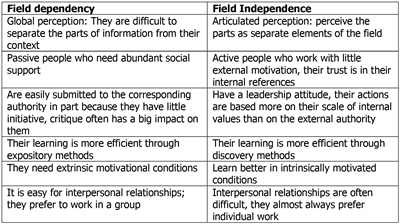
Source: Hederich-Martínez, 2007.
Within this same categorization are located intermediate subjects (INT), which have characteristics of the two groups of extremes (DC) e (IC) (Min & Reed, 1994).
These characteristics have a high incidence on the behavior of subjects in academic fields; in-deed, it has been observed that independent field students surpass in academic achievement their peers Sensitive to the environment.
4.4. Cognitive style and learning achievement in AABW
In the educational context the cognitive style is a very important factor because it determines how people perceive, store, transform and process information having a direct influence on the achievement of learning (García, 2015), (López Ó., 2008).
Around this the AABW or the so-called AABC (computer-based learning environments) have generated great expectation in terms of improving the learning achievement since they have ad-vantages over the differences in cognitive style, achieving greater respect for the pace of learning, in the same way favor different forms of social interaction and enable access to information from any point of navigation, combining different representations of the domain of learning (graph, videos, sounds, animations, etc.). However, there are several studies that have questioned the effectiveness of AABC (Spiro & Jehng, 1992), (Tergan, 1997).
Regarding the theme López (2008), suggests that the AABC require greater autonomy on the part of the student as far as the regulation of the learning is concerned; meanwhile, Astleitner & Leuner (Hermann & Detlev, 1995) they claim that the AABC have basically three difficulties; the first refers to the large amount of information that is presented to students, which can lead to the distance from the learning purpose, using some of the time in situations of little importance and leaving to attend to the truly important, the second difficulty is related to the structure itself of the AABC or AABW because they can cause spatial disorientation, losing sight of the heir archives between the contents treated, which hinders the structuring of the knowledge itself, as third difficulty is reported the great cognitive effort required by the student to achieve the organization of the volume of information presented to him.
By way of synthesis, the cognitive style is defined as the set of perceptual, analytical, intellectual, social and affective characteristics that make people process information in a different way, is very stable throughout life and is neutral, that is, it is not possible to say that one style is better than another (Hederich-Martínez, 2007), however, it is possible to state that it directly affects the achievement of learning.
The cognitive style of each subject coupled with the characteristics of AABC or AABW generate a certain degree of inequality for all students, because it causes the independent students of the field, given their cognitive structure, to obtain better academic performance in front of field-dependent students.
4.5. Metacognition and comprehension of texts
According to the framework, the metacognitive component plays a key role in reading comprehension. Two key metacognitive components that intervene in the regulation of reading com-prehension can be identified; knowledge of the purpose of reading (for what is read) and self-regulation of mental activity to achieve that goal (how to read), which requires controlling mental activity in a certain way and directing it towards a specific goal.
Both aspects are closely related; the way you read and regulate mental activity while reading is determined by the purpose you are looking for when reading. You do not read a text in the same way to pass the time to explain the content in a class; Neither does the same mental exercise if it is read to identify the main ideas, to look for the best title of a text, to deduce conclusions or to make a critical judgement of the contents of this (Cantillo, De la Hoz, & Cerchiaro, 2014) Brown (1986) notes that metacognition in the comprehension of texts involves the knowledge of four variables and the way they interact to facilitate comprehension.
The variables involved are in the first place; the text which includes the characteristics (structure, level of difficulty, degree of familiarity) of the reading materials that affect their comprehension and their memory. Second, the task is found, which includes the storage and retrieval requirements of information, which generate an execution by the reader. Thirdly, we can find the strategies, which are the activities that the reader deploys to store and retrieve the information. As and last place are the characteristics of the reader, his skill, his level of motivation and other states and personal attributes that influence understanding.
In the same way, metacognition in the reading process involves control and self-regulation processes. Such processes, according to Baker & Brown (1984) are as follows:
5. METHOD
The investigation raised an experimental design of 2x3 factorial type, with groups previously formed belonging to two regular courses of a private school in the city of Bogotá. The experience consisted in exposing the student groups to an Environment Based on the WEB for strengthening reading comprehension and scientific competencies.
The Environment Based on the WEB contains three (3) learning units related to textual typology in scientific texts: 1] Descriptive text, 2] narrative text and 3] expository text. At the end of each study unit all students individually presented an evaluation of reading comprehension through scientific texts. In total, three (3) evaluations were obtained for each student, which were averaged at the end of the study.
Before and after the experience the students perform test ESCOLA that is an instrument that evaluates the goal reading comprehension to analyze the possible problems in the strategy of reading of the children of 8 to 13 years, it is advisable that this test is complemented with the direct observation of beside a serious judgement by the parents or teachers and with tests that measure the performance and reading comprehension of children.
The main function is to identify the gaps in reading awareness and learn about the strategies that the students use in the readership process.
In addition, the masked figure test was used which is the instrument used to determine the cognitive style in its dimensions 1. Independence, 2. Dependence e 3. Intermediate, was elaborated by H. Witkin in 1950 but was standardized for the Colombian context by Hederich & Camargo in 1999 and its level of reliability is 0.91.
5.1 Description of the environment
Presentation of the course: the data relating to the course are retaken, name, pedagogical approach, target audience, duration and hourly intensity.
The second part consists of 3 study units selected for research, these were: descriptive text, narrative text and expository text, each unit has the following parts:
The third and final part is the farewell, this is done the final evaluation which allows evidence the mobilization of metacognitive processes, through the completion of the questionnaire ESCOLA (posttest).
The metacognitive scaffolding visualized by the study group was randomly performed through the following metacognitive trials.
5.1.1 At the start of the course
How much do you know about the subject of study?
How important do you think the content of this study topic is?
How competent do you feel for learning this unit?
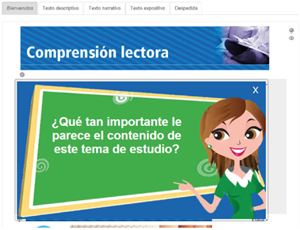
Image 1. Initial metacognitive activator.
Unit 1:
Have you been clear on the concepts of reading?
Are you able to respond to an assessment?
Can you make a synthesis?
Are you understanding?
Do you realize if you're following what you proposed?
Have their strategies been effective?
Unit 2:
Could you tell the characteristics of the narrative text?
Could you give a definition on narrative text?
Are you clear on the characteristics of a narrative text?
Unit 3:
Could you tell the characteristics of the expository text?
Could you give a definition on expository text?
Are the characteristics of an exhibition text clear?
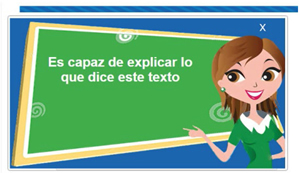
Image 2. AC image of the unit.
Before initiating testing and evaluations
Are you ready to answer the questions?
Are you able to test your understanding of this text?
Are you ready to demonstrate your understanding of this text?
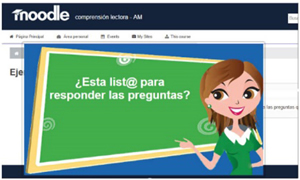
Image 3. Prequiz activator.
5.2. Methodological proposal. Design, production and implementation of the AABW
To achieve the objectives was designed of the course was used the methodology recommended in the book guidelines for the design, and implementation of virtual courses, the collection National system of educational innovation with use of ICT, Ministry of Education National, which gives us the roadmap of a virtual course, this is divided into 5 stages:
Stage 1 diagnosis and planning: it is the first step in the creation of a virtual course is characterized by the study that identifies the needs and learning objectives that are served, in addition to the analysis of the context and the target audience. This stage is done to have truthful information about the needs of the students in front of the training process, the contents and the quality levels.
Stage 2 pedagogical design: this contains and defines all the elements, in addition to the didactic strategies of the course, the result of this is the instructional script, the number of units and the thematic contents are defined in addition to the different OVA to be used, in this point the activities and evolutions related to the subject of study are designed.
Stage 3 resource production and educational modeling: two main activities are carried out at this stage; the first is the production of all the contents and resources that are developed for the course, the second is to define the paths of learning that in the previous stage have been established.
Stage 4 platform mounting: at this stage the course implementation is carried out in the LMS platform in our case Moodle V-2.9.1, this stage includes the development, the design of the different graphic pieces, their structure and their operation.
Stage 5 deployment and updating: it is the final stage where the strategies designed for the virtual course are developed and the course is carried out with the students, after an analysis of the development of the course, based on the different feedbacks given by the participants you can make a updating of both textual and multimedia content, evaluations and different activities that the course contains.
Description of the environment Web-based learning (virtual course)
For the development of our research was designed a virtual course mounted on the Moodle platform, for its ease of use and so that it could be reused. The course consists of 3 parts, the first is the welcome where the student will be greeted and has the following parts:
The second part consists of 3 study units selected for research, these were: descriptive text, narrative text and expository text, each unit has the following parts:
5.2. Procedure
The participants were assigned in the following way the 9th group was enrolled in the course of study and the group 9b in the control course, before starting the course they were applied the ETF test, each student carried out the test independently and in an autonomous way, a group session with a total of 2 sessions was necessary, this one was developed of a multimedia software that was copied in each one of the computers used, the professor and researcher Paola Intencia was present during the application of this instrument.
Subsequently each of the groups independently interact with the course in the academic spaces of the area of natural sciences, the time of interaction with the REDA was 30 hours distributed in three weeks.
Each student was assigned a user and password for entry to the Moodle platform, at the be-ginning, prior to the interaction with the computational environment, the student conducted a questionnaire ESCOLA (pretest) to demonstrate the initial status of each student in I count its metacognitive process, at the end of each learning unit the students carried out an evaluation, in addition to 2 intermediate reading comprehension tests concerning the subject of study, each one of the students carried out a total of 9 tests subjects discriminated in 2 exercises and a verifiable test of the achievement of learning by unit, which is taken as a reference.
Once the interaction with the computational environment was completed, the ESCOLA (post-test) questionnaire was re-applied in order to determine the final state of the students' metacognitive processes.
The metacognitive activators were randomly appeared to the study group at the beginning of each unit, when performing the proposed exercises. This is intended to determine the effects of metacognitive scaffolding in the process of reading comprehension and in the achievement of learning around natural sciences.
6. RESULTS
6.1. Initial conditions
Using the data collected in the research through the different instruments, a descriptive statistical analysis of the different categories that support the development of the student's metacognitive capacity and level of achievement is carried out. In the area of natural sciences, prior to the interaction with the computational environment on reading comprehension and scientific competencies. In the face of metacognitive capacity, the results obtained in the first application of the ESCOLA questionnaire (pretest) are analyzed. As for the level of achievement, the notes previously obtained by the students in the subject of natural sciences are described.
6.2. Initial metacognitive abilities in reading comprehension
The questionnaire ESCOLA (Reading Awareness Scale) was answered by the students individually prior to the interaction with the computational environment (pretest). The results thrown are presented below.
Table 2 shows the general average of the reading consciousness scale, where the mean corresponds to 95.00 and the standard deviation corresponds (FROM) to 6.58. The minimum score was 81 and the maximum was 106 points of 168 possible.
Table 2. Descriptive statistic of the scale of reading consciousness. ESCOLA (Pretest).
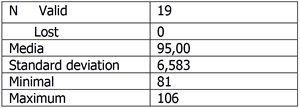
Source: own elaboration.
Source: initial metacognitive activator (performed by the author for the AABW).
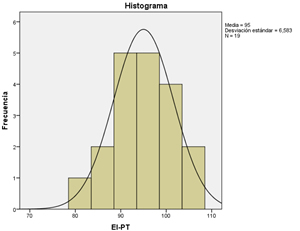
Graph 2. Scoring histogram questionnaire. ESCOLA (Pretest).
The average of each of the metacognitive processes corresponding to the questionnaire and ESCOLA is indicated in an individual way. The average metacognitive processes indicate the presence of medium-sized metacognitive abilities by the students.
6.3. Previous learning achievements
The notes previously obtained by the students in the subject of natural sciences were considered for the analysis of the effects of the scaffolding and will be described below.
The teacher of the natural sciences area was asked for the notes obtained by the students corresponding to the average of two scientific competency assessments carried out during the first semester of the academic year. Students are assessed on a numerical scale from 1 to 10. The aver-age of the notes is 5.21; with a standard deviation (OF) of 1.47. On a maximum score of 10, the minimum value was 3 and the maximum of 7.
Table 3. Descriptive statistic of the scale of reading consciousness. ESCOLA (Pretest).
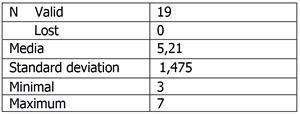
Source: own elaboration.
The Graph 3 shows that 4 of the students are evaluated with a note of 3 that corresponds to 21.1%, 1 of the students is evaluated with a note of 4 that corresponds to 5.3%, 6 students are evaluated with a note of 5 corresponding to 31.6%, 3 of the students obtained a note of 6 corresponding to 15.8% and 5 of the participants in the study achieved a note of 7 representing 26.3%. It is noted in the figure that the performance in the evaluations does not describe a normal distribution.
Source: AC image of the unit (performed by the author for the AABW).
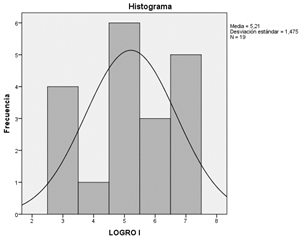
Graph 3. Histogram of Notes Natural Science Test 2015.
6.4. Analysis of the effect of the program
In order to study the effect of the software in its two modalities on the metacognitive processes and their different variables and on the achievement of learning, a multivalent analysis of covariance (Mancova) was carried out. For this analysis, the study-dependent variables were 1] the metacognitive capacity (planning, supervision, evaluation and good Reader) and 2] the academic achievement (average of the evaluations of each unit). Two independents are considered in the analysis; 1] Working with the computational environment that differentiates students who worked in the presence or absence of metacognitive scaffolding and 2] the cognitive (dependent, independent and independent field) style. The analysis Mancova is carried out taking as covariates 1] The initial data of the metacognitive capacity of the students, the pretest of ESCOLA (obtained by the initial application of the questionnaire ESCOLA) and 2] the notes previously obtained in the area of Natural Sciences.
In the first instance, the detailed description of the dependent variables for the case is analyzed; the metacognitive capacity (planning, supervision, evaluation and good reader) and the achievement of learning (average of the evaluations of each unit).
6.5. The dependent variables (posttest ESCOLA)
At the end of the interaction with the computational environment the students responded again the questionnaire ESCOLA. Table 4 that of correlations presents the correlations of the different metacognitive processes; planning, monitoring, evaluation and good reader and the corresponding variables.
This allows to observe the metacognitive profile of the students one the interaction with the computational environment has been completed. The results thrown are presented below.
The general average of the reading consciousness scale is shown, where the mean corresponds to 124.74 and the standard deviation corresponds (FROM) to 31.6. The minimum score was 82 and the maximum was 163 points of 168 possible.
Table 4. Descriptive statistics of the reading consciousness scale. ESCOLA (Postest).
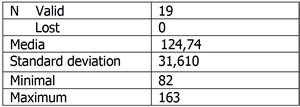
Source: prequiz activator (performed by the author for the AABW).
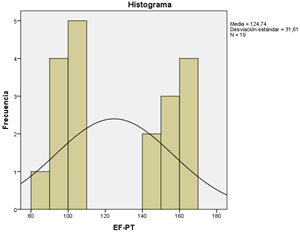
Graph 4. Scoring histogram questionnaire ESCOLA. (Postest).
The average metacognitive processes indicate an increase in metacognitive capabilities according to the results of the initial application.
6.6. Natural Science learning achievement
It is important to remember that the achievement of learning was assessed individually at the end of the interaction with each of the units that constitute the computational environment. The overall achievement was obtained from the average of the exams presented by the students. The average of the general achievement corresponds to 7.30 with a standard deviation (OF) of 1.95. The minimum value is 4 and the maximum is 10, representing the results of the three tests at the maximum possible note.
Table 5. Descriptive statistics of achievement of general learning in Natural Sciences.
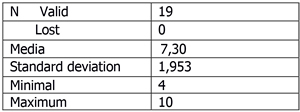
Source: own elaboration.
The distribution of the notes obtained by each one of the students who participated in the study is presented below.
Source: own elaboration.
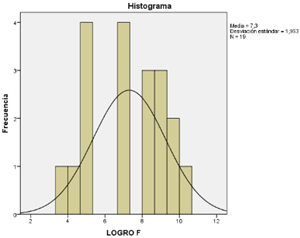
Graph 5. Histogram of general learning achievement in natural sciences.
6.7. Multivariate analysis (Mancova)
The results of the Mancova show that the resulting models have a high level of prediction of the different dependent variables included. Undoubtedly one of the variables that reaches greater explanation of its variance is the achievement of learning, which is reached to predict 98.1% of the variance (R2=0,981).
As for the different variables of the questionnaire ESCOLA we can find significant relationships in a generalized way being the process of evaluation in the variable person with 99.3% of the variance (R2=0,993) the highest; followed by planning in the person (PF person) category with 98.7% of the variance (R2=0,987), followed by a good reader (BF reader) with 98.5% of the variance (R2=0,985), followed by the aforementioned learning achievement; Subsequently, the monitoring process is reported in the task and text variables (SF Task) and (SF text) respectively with 97% of the variance (R2=0,97), in consecutive the final evaluation process is reported in the task variable with 96.8% of the variance (R2=0,968), followed by the final planning process in the task variable (PF task) with 96.7% of the variance (R2= 0,967), to end is found, the monitoring process in the person variable (SF person) with 93% of the variance (R2=0,930). Indicating with the analysis of the relationships between the covariates and the variables the results show that each of the covariates shows a significant association especially with the final state of the same dependent variable and in some cases with other variables.
In the case of planning in the person variable, significant relationships are established with this same process in the same variable with (F=23,39; p=0,008) and with a slightly lower value with the final evaluation process in the task variable with (F=8,15; p=0,046).
On the other hand, the planning process in the task variable establishes significant relationships with the planning processes in the variable’s person and task with (F= 19,51; p=0,012) and (F=6,91; p=0,058) respectively. For the monitoring process in the person variable only a meaningful relationship with the same process is established in the same variable with (F=9,03; p=0,040). As for the process of initial supervision of the text this establishes significant relationships with the final planning process of the person with (F=10,28; p=0,033). On the other hand, the initial evaluation process in the person variable managed to establish different relationships considered significant; In the first instance we find the same process in the same variable with (F=24,07; p=0,008), followed by the final planning process in the variable person with a (F=15,13; p=0,018) and ends with the achievement of learning where one (F=8,07; p=0,047) is reported.
Confronted with the condensed strategies in the category good reader, this one reports significant relations with three variables in first place with the same process in the same variable with (F=15,11 p=0,018), followed this by the achievement of learning with (F=8,71 p=0,042), and finally, the final monitoring process is reported in the task variable with (F=7,32 p=0,054).
On the other hand, the group variable establishes significant relationships with all categories of the ESCOLA, being these highly significant.
In relation to the main effects, the most significant effect is given by the presence of meta-cognitive scaffolding, since the results show an important association with the achievement of learning. A simple data survey reveals that students who worked in the environment with meta-cognitive scaffolding showed much higher results than their peers who worked in the environment without metacognitive scaffolding. Similarly, it is evident that the presence of metacognitive scaffolding favored the increase of metacognitive skills, i.e. the planning, monitoring and evaluation processes.
On the other hand, the variable “the cognitive style in the DFI dimension” does not evidence any significant associate, which leads to suppose that the scaffolding minimizes the differences previously present and given by the characteristics of the cognitive style of the students.
6.8. Limitations
There are several limitations that need to be considered for the interpretation of their conclusions. Three important limitations can be mentioned.
In the first instance we can mention that strict sense, the study was not an experimental investigation, which included all the controls of rigor, but had to be limited to a situation experimental with two groups previously formed of degree ninth in the academic space of Natural Sciences in a private school of the city of Bogotá. For this reason, it is not possible to generalize the results to all the high school students in our educational system. However, the research leaves an open space that allows other researchers to continue conducting studies in different domains of knowledge and academic levels.
On the other hand, it is stressed that the instrument used to measure the level of reading awareness reached by high school students, as for this was used a questionnaire author report (reading awareness scale, ESCOLA), widely used in this research area. For this reason, there is the probability that there is uncontrollable bias given by the tendency of the students to give socially accepted responses, a factor that the investigation failed to control.
Finally, it is important to refer to the size of the sample because when they subdivide the groups by all the independent variables, this is very small. For later experiences it is suggested to increase the sample size.
6.9. Recommendations for future research
For further research on the subject, it is important to take into account at a broader level of study the characteristics of text as a fundamental element in reading comprehension, in the same way it is important to extend the size of the sample in order that the results can be generalized, as it would be interesting to expand the learning units proposed for the environment because although the research showed important results, changes to metacognitive levels imply representative interactions with the environment.
On the other hand, it would be interesting to carry out the research with the integration of the reading comprehension component and the areas of exact and natural sciences in order to achieve inference and to promote the performance of the students in standardized tests to through web-based learning environments.
7. CONCLUSION
The present research contributes in the field of design of learning environments based on the Web AABW in the following way:
According to the specialized theory in the field of information technologies applied to education, the importance of the design of metacognitive scaffolds is retaken in order to strengthen the possibilities of monitoring and regulation in the process of learning and in this way encourage reading comprehension and therefore the achievement of learning. For the purposes of this study the data provided by students involved in the investigative process show that a metacognitive scaffolding included in an Environment Based on the WEB increases their metacognitive skills and consequently the achievement of learning in reading comprehension tests of scientific texts.
On the other hand, it is important to emphasize the statistical technique of high complexity that was used in the present research to determine the interaction of the variables. It uses multiple robust statistical instruments and techniques such as the covariance analysis Mancova, to study the impact of independent variables in addition to controlling different variables associated that may be related to variables dependent. This analysis contributes to give the study and the protagonists of the educational field a greater validity and reliability.
Another important element that contributes significantly to the educational context refers to the population, since the majority D studies take as a reference to the university population, the present research focused its attention on the population of secondary showing evidence of how metacognitive strategies in reading comprehension play a fundamental role in the performance of standardized tests in the area of natural sciences in learning environments based on the web and in turn as it affects the presence of a Metacognitive scaffolding on these variables.
The research provides relevant information regarding the importance of designing and implementing Web-based learning environments with scaffolding that favors the development of meta-cognitive skills. Considering the different processes and variables that are involved when the subject is confronted with a scientific type reading. In the same way this context provides tools for the realization of control and monitoring of the learning process of the students. This research is of greater interest to the educational community of the country because the use of virtual learning environments is widespread and progressively becoming closer and indispensable to the educational work, making it necessary to promote didactic strategies such as computer scaffolding in order to obtain greater learning and better performance in the different areas of knowledge in the student population of secondary school.
AUTHOR
Rómulo Andrés Gallego Torres
Research professor and evaluator on topics such as e-learning, digital communication, new edu-communicative models, new digital narratives and Digital StoryTelling. Professional expert in the development of digital solutions, graphic designer and producer of UNITEC, social communicator of the Fundación Universitaria San Alfonso, master in Information Technology applied to education at the National Pedagogical University, PhD in Education; school, language and society of the University of the Basque Country, founder of Visual Communication - Creative workshop, lover of reading on topics related to ICT, education and social sciences and convinced that democratic access to education has its own line of development in the proper use of new technologies.
andresgallegot@gmail.com
Orcid ID: https://orcid.org/0000-0001-5074-6781